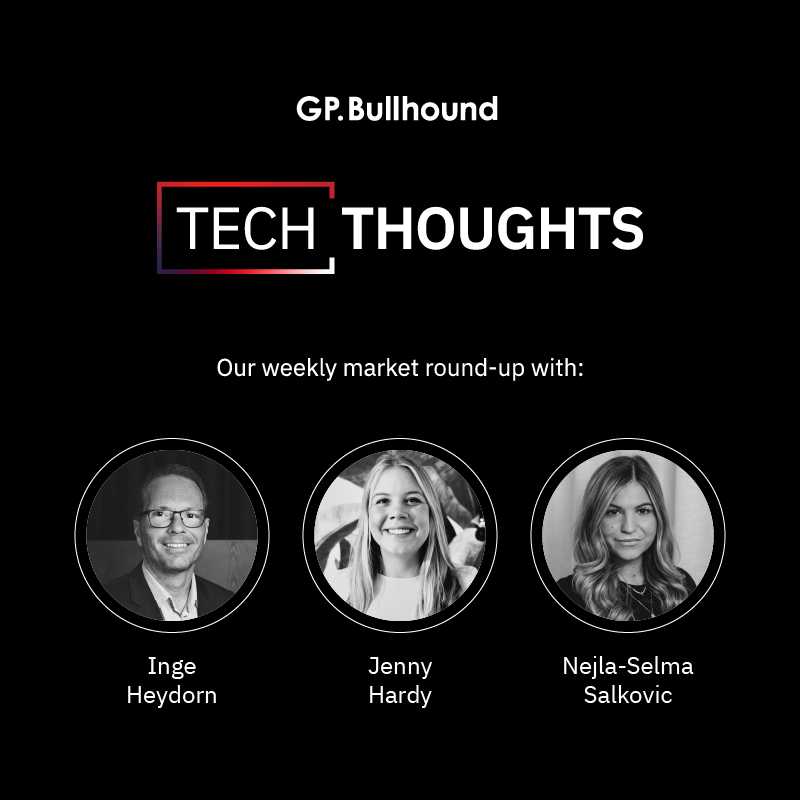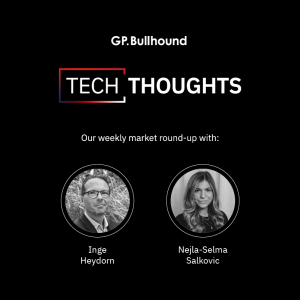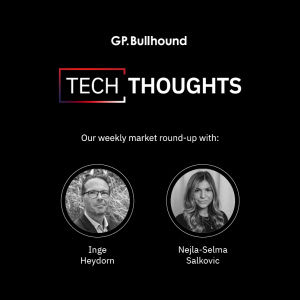Tech Thoughts Newsletter – 5 May 2023.

Market: More volatility this week with concerns around the economy impacting the US banking sector. We feel like a broken record talking about the market’s preoccupation with interest rates and inflation. No liquidity crisis in big tech though – Apple’s $90bn buyback announced last night!
Portfolio: We have increased our positions in Infineon and NXP Semiconductors ahead of earnings and AMD on weakness after the results. We expect all three companies will enjoy strong growth in the second half of the year and 2024.
AMD gaining semi content in AI; clear performance leadership in CPU
- AMD (owned) reported a solid enough quarter, beating revenue and EPS expectations. Q2 guidance disappointed vs expectations and we think there are a few factors at play:
- (1) Datacentre revenue is a mix of strong cloud/hyperscaler and weaker enterprise (which is typically more sensitive to the macro uncertainty); (2) we think there might still be some inventory to clear at hyperscalers; and (3) Genoa ramp is taking longer than prior server CPU cycles given it’s a new platform across new memory content (DDR5) and PCI 5.
- Positively though, they are benefiting from the AI build: “our AI activities increased significantly in the first quarter..” and their confidence in a strong second half speaks to Genoa and Bergamo’s product ramp as well as some cloud AI wins with their MI300 GPU.
- There is no doubt from our perspective that they are continuing to gain share from Intel in CPU – Their performance, energy efficiency and therefore total cost of ownership (TCO) advantage makes it a very easy decision to choose them over Intel for hyperscaler x86 workloads.
- What’s interesting for the future product evolution is AMD having both CPU (for low level inference) and GPU (for dense large language model inference) capability in its MI300 chiplet, and being able to combine both in the compute of high performance AI workloads.
- An interesting development on Thursday were rumours that Microsoft is working with AMD in AI processors.
- It’s not exactly clear to us what sort of partnership this would represent, but it makes sense that Microsoft wants an alternative to incumbent Nvidia
- We own both Nvidia and AMD (and Microsoft) and we think both can win in AI, for different workloads. We think AMD will likely take some of Nvidia’s 95% share of the GPU market, but that ultimately both will see significant demand for their chips in AI.
- Super Micro – a leading server business – provided some helpful commentary around the hyperscaler and AI ramp which supported AMD’s confidence around second half growth.
- Although Super Micro’s reported results were hampered by continued component shortages, it is clear that the underlying demand for their products – including those related to AI – is strong, with backlog at record levels entering a seasonally strong June quarter, and expecting strong September/December quarters
Portfolio view: We own AMD and continue to think that much of the value around AI will accrue in the short to medium term to the AI infrastructure and semiconductor enablers.
AMD and Super Micro’s combined comments also makes us more confident in TSMC’s forecasted second half recovery.
Auto semis continuing to see strong demand and strong pricing
- Infineon (owned) beat and raised at its results – it had raised its guidance back in March, which it firmed up higher this week.
- Electric Vehicle semiconductor content and renewables is still driving demand, and, like NXP, On Semi, Microchip (below) and STMicro last week, pricing in auto semis is still very robust, and structural demand is ongoing.
- On upgraded EPS it’s trading on 12.5x this year’s EPS, which we think is too low for the compounding earnings/structural content growth/FCF generation.
- NXP (owned) also beat on sales and EPS and guided ahead. Like Infineon, our thesis is around their autos business, which was +17% yr/yr and up qtr/qtr.
- On Semi (not owned) also had a good set of results and remains supply constrained across several auto products. They also expect to see quarter over quarter growth in autos, and they also continue to increase the value of their business under long-term supply agreements (we think close to all of On Semi’s auto business for the next 12 months could be under long term agreements)
- Microchip (owned, very small position) reported a quarter inline with expectations. That means 21% growth yr/yr with a gross margin of 68%. The company is very profitable and executing well in the downturn, helped by its exposure to very stable segments like industrial, Defence and Automotive. The company has experienced an increase of push out of orders but still no pressure on prices. Microchip is guiding for 2Q sales slightly up from 1Q.
- For particular pockets of auto demand still far exceeds what they can supply, and that’s led to a completely different risk dynamic for semis with OEMs signing up to long term, non-cancellable/returnable contracts
Portfolio view: We continue to prefer exposure to auto and industrial components vs smartphone/PC.
More broadly in semis it’s striking how much the management teams are focused on managing any down cycle or slowdown and managing volatility in a much more conservative way than we’ve seen in the past. The implication long term supply agreements has on the whole semis industry is so significant – Risk is being transferred away from the foundries and IDMs (and in turn) the semicap equipment players via these long term supply agreements.
ICE to EV transition continues – April EV data
- We’ve been tracking monthly electric vehicle sales numbers for our holdings in Infineon and NXP which are driven by the ICE to EV transition and the semi content increase.
- US April BEV/PHEV sales were up 31% and 42% as penetration continues to move higher
- Looking at auto OEM results, VW BEV deliveries rose 42% in Q1 to 141k (7% of total deliveries, and critically a much higher share of the backlog)
- Stellantis too reported strong growth in its PHEV Jeep.
- We think the barriers to entry in an EV world are even lower than the traditional combustion engine market, which has historically been a difficult industry in which to make a sustainably high return – we expect to continue to see price wars, especially as companies need to meet their EV production targets, but this will continue to stimulate demand.
Portfolio view: we avoid owning any auto OEMs, Tesla being the one we’re most often asked about. We think the barriers to entry in an EV world are even lower than the traditional combustion engine market, which has historically been a difficult industry in which to make a sustainably high return. But the continued increase in EV penetration is a clear positive for the semi component suppliers, who all have pricing power.
Apple’s resilience continues
- Apple (owned) reported a solid quarter with 3% sales growth ex currency effects.
- The services business improved qtr/qtr especially outside gaming and digital advertising (which remains weak), and critically iPhone sales held up very well, although we think helped by the pent up demand due to the closure of the factories during the December quarter.
- Demand for iPhones was especially strong in Emerging Markets like India and Brazil (and was a focus of Tim Cook’s comments as the next leg of growth)
- The company has also had a positive effect from the reopening of China.
- Mac sales were clearly impacted by the weaker economic environment – down 31% yr/yr.
- Guidance is for a similar level of yr/yr growth in the coming quarter which implies a qtr/qtr decline – inline with the historic pattern ahead of the new release in the September quarter.
- A $90bn buyback was announced, as well as a dividend increase – tech changed(!) but it does reflect big tech’s robust cash balance sheets more broadly – and puts them in a good position to reinvest to maintain tech leadership and – in Apple’s case – continue to gain share over Android
Portfolio view: Very stable performance and outlook from Apple The company continues to strengthen its competitive position in a tough market environment.
Smartphone market showing signs of a bottoming
- More broadly, within the mobile handset market, we saw results from Qorvo (not owned) and Qualcomm (not owned).
- Both companies enjoy strong positions in terms of market share in the handset market and both have exposure to Apple, Samsung and the Android market. Both are indicating that 2Q will be the bottom and that most of the inventories will be worked off by the end of the quarter.
- Qorvo is quite optimistic about the second half as they are gaining share of content in the new iPhone while Qulacomm sounds more cautious.
- Qorvo is also giving some mid term guidance which is quite positive all the way into 2024 as sell-in volumes will grow due to the inventory correction that’s been ongoing for the last 8 months.
Portfolio view: We also believe that the semiconductor demand towards the handset market will bottom out in 2Q. The question is however how much better end demand and sell though volumes will become given the economic uncertainty in the world. China remains a big uncertainty and we continue to limit semi exposure within the PC/Smartphone space.
For weekly insights on the latest market updates, please subscribe to our Tech Thoughts podcast.
For more information about the latest trends and forecasts, please visit our official Tech Thoughts page.
We provide investors with access to category leading technology companies, globally. Our assets under management have a total value of more than $1bn, and our limited partners include institutions, family offices and entrepreneurs. Learn more about our funds here.
Enquiries
For enquiries, please contact:
Inge Heydorn, Partner, at inge.heydorn@gpbullhound.com
Jenny Hardy, Portfolio Manager, at jenny.hardy@gpbullhound.com
Nejla-Selma Salkovic, Analyst, at nejla-selma.salkovic@gpbullhound.com
About GP Bullhound
GP Bullhound is a leading technology advisory and investment firm, providing transaction advice and capital to the world’s best entrepreneurs and founders. Founded in 1999 in London and Menlo Park, the firm today has 13 offices spanning Europe, the US and Asia. For more information, please visit www.gpbullhound.com.

